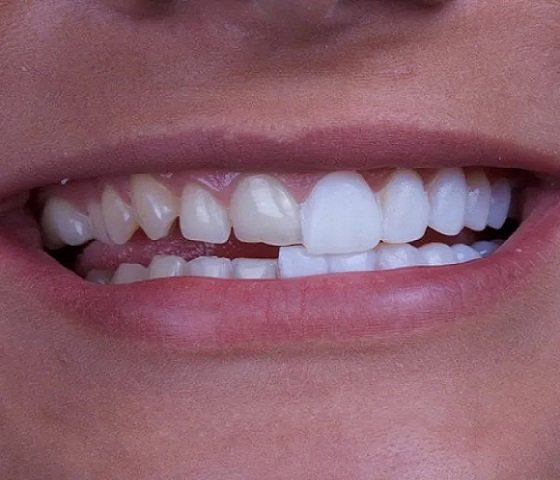
¿Son buenas las carillas? Es una pregunta común en mi consulta, estéticamente no hay dudas de que las carillas son hermosas, hacen que la sonrisa sea perfecta. Estas presentas muchas ventajas, pero ¿Todos pueden tenerlas? O ¿Funcionalmente son perfectas?
Primero debemos entender qué es una carilla. Para ello debemos entender que es una estructuras que recubre al diente, su material puede variar entre resina o porcelana. Siendo las de resina las más comunes en el mercado debido a sus bajos costos.
¿Are veneers good? This is a common question in my practice, aesthetically there is no doubt that veneers are beautiful, they make the smile perfect. They have many advantages, but can everyone have them? Or are they functionally perfect?
First we must understand what a veneer is. To do this we must understand that it is a structure that covers the tooth, its material can vary between resin or porcelain. Resin veneers are the most common in the market due to their low cost.

¿Cómo funciona?
Para colocar las carillas es necesarios desgastar la superficie del diente, ya que si colocamos las carillas de manera directa estás, pueden tener un tamaño exagerado. He aquí la primera desventaja, desgastar un diente sano puede generar muchas consecuencias a futuro, las caries se aprovecharían de la estructura debilitada; estás podrían ser comunes en boca. La sensibilidad en las piezas dentarias puede estar presente, siendo en algunos casos muy dolorosa para el paciente y la halitosis "mal aliento" sería muy intenso. En mi consulta he visto numerosos casos de carillas fallidas, siendo el error más común, el tamaño de éstas. retirarlas es un proceso tedioso, de mucho tiempo y cuidado ya que al estar los dientes debilitados, el paciente tiende ser extremadamente sensibles al agua, aire, frío. Por esta razón, no todos los casos son aptos para instalar carillas de resina.
¿How does it work?
To place the veneers it is necessary to wear down the surface of the tooth, because if we place the veneers directly, they can have an exaggerated size. Here is the first disadvantage, wearing down a healthy tooth can generate many consequences in the future, cavities would take advantage of the weakened structure; these could be common in the mouth. Sensitivity in the teeth may be present, being in some cases very painful for the patient and halitosis "bad breath" would be very intense. In my practice I have seen numerous cases of failed veneers, the most common error being the size of the veneers. Removing them is a tedious, time consuming and careful process, as the teeth are weakened, the patient tends to be extremely sensitive to water, air, cold. For this reason, not all cases are suitable for the installation of resin veneers.

Recomiendo siempre escuchar varias opiniones de distintos odontólogos para así tomar una decisión correcta, cuando es algo estético es de suma importancia que se estudie muy bien el caso para así no crear un problema donde no existía. Algunos pacientes sí necesitan de carillas ya que por algún traumatismo o caries avanzada, es necesario recubrir todo el diente para poder mantenerlo en boca, regresandole su fuerza y estética, cuando el paciente presenta diastemas (espacios entre un diente y otro) o microdoncia (dientes pequeños con respecto al maxilar).
Carillas de porcelana
Estás carillas requieren de más preparación previa para su instalación. Primero se tallan los dientes "desgastan" y luego se toma impresión con un material que detalla cada músculo y hueso de la boca, está impresión se envía al técnico que se encarga de hacer maravillas y crear piezas dentales de perfecta estética, hasta que finalmente se instala y la sonrisa queda como una obra de arte. El problema aquí es el mismo que las carillas de resina, en este caso el desgaste es mucho mayor y el paciente no tendría la opción de quitárselas a futuro, se debe realizar mantenimiento cada cierto tiempo y se debe tener muy buena higiene bucal para no ser afectados por caries y sensibilidad.
I always recommend listening to several opinions from different dentists in order to make the right decision, when it is something aesthetic it is very important to study the case very well so as not to create a problem where it did not exist. Some patients do need veneers because of trauma or advanced caries, it is necessary to cover the entire tooth to keep it in the mouth, returning its strength and aesthetics, when the patient has diastemas (spaces between one tooth and another) or microdontia (small teeth with respect to the jaw).
Porcelain veneers
These veneers require more preparation before installation. First the teeth are carved "worn" and then an impression is taken with a material that details every muscle and bone in the mouth, this impression is sent to the technician who is in charge of making wonders and creating dental pieces of perfect aesthetics, until it is finally installed and the smile is like a work of art. The problem here is the same as resin veneers, in this case the wear is much greater and the patient would not have the option to remove them in the future, maintenance must be performed from time to time and must have very good oral hygiene to not be affected by decay and sensitivity.

Con este artículo no intento desmeritar a las carillas, quiero crear consciencia ya que he visto a muchas personas querer colocarse carillas sin medir las consecuencias; es triste luego ver cómo esos pacientes terminan perdiendo sus dientes naturales por una moda. No todos los casos son iguales, existen pacientes que es necesario colocarles carillas, pero mi recomendación para aquellos que quieren tener los dientes "perfectos" es intentar primero la modalidad de la ortodoncia, corregir la mal posición dentaria y luego realizar un blanqueamiento. de esta manera sería algo más natural, no se estaría destruyendo de manera directa la estructura dentaria y no se expondría tanto a consecuencias mayores. Esperó haber aclarado muchas dudas con esta publicación
I have seen many people who want to have veneers without measuring the consequences; it is sad to see how these patients end up losing their natural teeth because of a fad. Not all cases are the same, there are patients who need veneers, but my recommendation for those who want to have "perfect" teeth is to first try the orthodontic modality, correct the bad dental position and then perform a whitening. In this way it would be something more natural, it would not be directly destroying the tooth structure and would not be exposed to major consequences. hope to have clarified many doubts with this publication.¡Hasta la próxima!

- La portada de esta publicación fue realizada en canva en su versión gratuita.
The cover of this publication was made in canva in its free version.
- El texto ha sido traducido por Deepl en su versión gratuita
The text has been translated by Deepl in its free version.